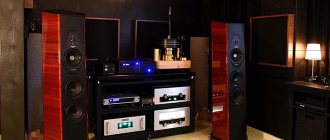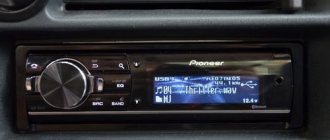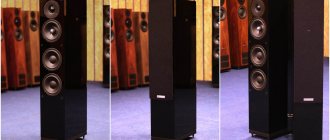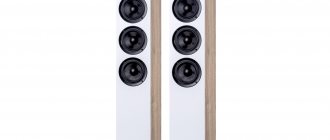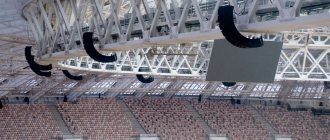Arslab AC3
Fomin Vsevolod, 04/18/2012
Pros: Full three-way speaker system. The tweeter has a one-inch silk dome and one-inch voice coil. The midrange driver is six inches in diameter, with a polypropylene cone, metal bullet (to cool the voice coil) and a one-inch voice coil. Low-frequency loudspeaker (there are two of them in ARSLAB AC-3), six inches in diameter, with a paper diffuser. The body is made of MDF and covered with high-quality veneer. Externally, the AC-3 looks quite compact and does not stand out much from the general ensemble of video-audio components, with a large plasma and a stand for audio equipment. ARSLAB AC-3 also boasts a good frequency response, extending from 30Hz to 20kHz. It is worth noting good angular characteristics. At angles of 30 degrees, a significant drop in the frequency response of the AS-3 is not observed. Such properties will have a positive effect on the placement of these speakers in the room. In principle, their placement is not critical relative to the listening point. Well, the most important advantage. ARSLAB Classic AC-3 easily competes in both quality of finish and cost with more expensive competitors. My friend and I were convinced of this personally.
Disadvantages: In my opinion, the main and perhaps the only disadvantage of these systems is the RZ. Before purchasing, my friend and I re-read all the reviews and looked at all the measured graphs that were for these systems. The lower limit of RZ for the AC-3 is around 3.2 Ohms, and not every amplifier can handle this resistance. We also encountered this problem. Most very budget amplifiers and receivers are only capable of operating at loads of at least 6.5 ohms. Otherwise, at maximum volumes, either protection will be triggered or nonlinear distortion will sharply increase. Actually, budget amps won’t have any bass either. As a result, knowingly and armed with charts, we spent a long time selecting the right amplifier and we found it. The amplifier cost us a little less than the cost of the speakers themselves.
Comment: In my opinion, ARSLAB Classic AC-3 is a good speaker system in terms of price-quality ratio. I was pleased with the quality of the finish of the case and its overall dimensions. To be honest, we didn’t think that they would practically get lost in a small hall. Personally, I liked the high detail in the mid and high frequencies. When the speakers “warmed up” they started playing like crazy, which we found out after the signal was sent analoguely, through the heating radiator, from the neighbors below. In the future we plan to build a full-fledged cinema based on the ARSLAB Classic AC-3, but what’s most surprising is that there are two speakers For now, we have enough to spend on music and films and to torture our neighbors. ))))) Sincerely, Vsevolod Fomin.
Decent sound to the masses: how Arslab seeks and finds a balance between price and quality of speakers
Floor-standing acoustics Arslab Classic 2
Choosing an acoustic system is a headache for a music lover. Yandex.Market suggests that a set of speakers costs from ten thousand to ten million rubles. So is it possible to enjoy music by purchasing “serious” equipment and not go broke?
High-End acoustics cheaper than a car exist, and are made 10 hours away by car from Moscow. A dozen of our engineers in the Riga workshop combine wood and veneer for cabinets with the best electronics from Asia and Europe, producing Arslab speakers.
Audio mania on the acoustics market since 1997. During this time, we created a website with products from almost hundreds of manufacturers and an entire knowledge base on acoustics, which is used by thousands of people every day. More than 50% of customers return to us for new purchases.
Making the acoustics ourselves was not an easy decision. We would like to tell you how we got to this point.
Founding Fathers
Russian electronics retail emerged from the chaos of Gorbushka and the Riga market.
It was there that Artem Firemark, the future founder of Audiomania, traded in the mid-90s. A young businessman noticed that audio equipment is as good as televisions, but no one really understands it. Artem spent hours delving into the intricacies of the sound of different speakers, not forgetting about business. By the beginning of the 2000s, Audiomania already had two acoustics stores with listening rooms. During this period, Artem met Yuri Fomin, a sound engineer for Soviet rock bands and an audio equipment designer with a lot of patents and his own company F-Lab.
The entrepreneur and the engineer agreed on the desire to make their own High-End acoustics, which would be affordable for compatriots with average incomes and at the same time allow them to enjoy playback quality at the level of leading brands.
Yuri Fomin and bookshelf acoustics Arslab Old School Superb 90 / Photo by “Stereo & Video” magazine
How Arslab developed
2004
: F-Lab, together with Taiwanese TB Speakers, produces speakers for the global brands Jetbalance, Defender and AVE.
2008
: Firemark and Fomin present their own speakers at CES in Las Vegas. President of TB Speakers Norman Hang invites Artem and Yuri to create acoustics under a new brand, using the developments of two companies. US partners are investing in Arslab. The World Audio Distribution company was created to promote acoustics to the American market. Taiwanese loudspeaker cabinet manufacturer Grand East is offering production facilities for the project.
2009
: Arslab will present the Classic line at CES in Las Vegas and collaborate with the German Ceratec and the Danish-Chinese Wavecor.
2013
: Production is completely transferred to Riga. The capital of Latvia supplied receivers and speakers to all corners of the USSR. Then the Union collapsed, and after it the industry. But the personnel did not go away: veterans of the Soviet Radiotehnika formed the backbone of Arslab production.
Engineers, led by Yuri Fomin, got to work. Emotion models and Monitor and Old School audio systems were added to the Classic line. The output increased to 2,000 products per year, with a potential capacity of another thousand. Let's see how Arslab managed to find a niche and gain a foothold in it.
Minimum requirement
Arslab's philosophy boils down to two words: the bare minimum.
The more expensive the material, the better the properties. But there is a threshold beyond which the price is excessive. We try to maintain the limit beyond which costs cease to be adequate to the return. This does not mean that we are content with average quality electronics and materials. We are constantly looking for new suppliers. The filling for the speakers comes to Latvia from Taiwan, Germany and Scandinavia.
In our line you will not find equipment more expensive than two thousand dollars, and not only because of the reasonable choice of materials. To cut costs, we have reduced the number of intermediaries to a minimum. We assemble the acoustics ourselves, package them and sell them in Audiomania stores or on the website.
In addition, we do a significant part of the work on new projects on the computer before touching wood and electronics (pre-production models are created in the next step). As a result, we do not waste material in vain and save on it.
Having released a product, we do not wave our hand at it with relief, but continue to test it. On average, each acoustic model receives a small upgrade every six months. We really love audio technology. Artem Firemark does not leave the Arslab production workshop and personally inspects suppliers, studying every detail.
The result of several years of work is 18 models of speaker systems, including floor-standing and bookshelf speakers, active subwoofers and center speakers. Let's look at a few of them.
Arslab Classic 1
According to the hifiNews portal, these bookshelf speakers are “acoustics with which you can safely begin your acquaintance with the world of high-quality sound.” Classic 1 - entrance model is slightly more expensive than 40,000 rubles. The magazine avreport.ru emphasizes that the speakers provide “deep bass and lively high frequencies with a distinct texture.”
Arslab Emotion 2 SE
In 2014, the compact floor-standing acoustics Arslab Emotion 2 SE debuted at the High End Munich exhibition in Germany. Artem Firemark shares his thoughts that arose after the exhibition:
...we realized that people didn't really need an entry-level speaker at this price point, so we ended up with the SE line, which has a Morel tweeter, improved cabinet damping, and a filter.
The model is suitable for small and medium-sized rooms. The body is slightly tilted. “The overall dynamics, sharp contrasts and drive for acoustics of such dimensions [150 x 860 x 280 mm] are very convincing,” writes the online magazine AudioVideo Salon.
Arslab Old School Superb 90
Soundex.ru write that despite the name and design, the sound of the speakers cannot be called old school.
“They create an open, detailed soundscape with powerful punch in the bass. At the same time, the upper bass does not push into the middle and does not mask the details of the attack. Hence the very moving and lively basis of the music, which will not allow you to be distracted from listening to almost any material.”
PS Arslab together with the Audiomania company offers to take part in a special promotion “Week with Arslab”.
As part of this promotion, anyone can receive a pair of Arslab speaker systems for free use for one week. PPS Other current promotions from Audiomania can be found here.
Pioneer N-50AE
Reviews
- prim maxim
Pros: - Played great with a tube stereo amplifier and Monitor audio silver 8. I didn’t like the 32 bit function - the acoustics play much richer with pure audio. - Media server is a great thing. I set up a DLNA server on my home station and now the entire media library is stored there. I solve the problem of rewinding in turn through a TV connected to the player via optical fiber; the TV has access to a DLNA server. And when playing an album that is recorded in one file, the television codec can do everything that the player cannot. — Very compact.
Cons: I give it 4 only because of problems with managing the device. — The proprietary Control App application is very buggy; it often cannot find the device on the home network. — The display is very small, when choosing compositions it’s difficult to see anything from 2 meters away. — The signal receiver from the remote control has small reception angles. — Problems with connecting devices via BT, you need a special receiver. - Can't read m4a. — Can’t rewind audio files. — Doesn’t know how to play from smartphones if you don’t have an iPhone
Comment: For its cost of 25 tr. quite a suitable device. At a cost of at least 10 tr. I would think more about the shortcomings.
— Babak Alexey
Pros: Strict appearance, looks great with pioneer equipment, not bad sound.
Cons: No USB on the rear panel
Comment: After using this player for over a year, there is a lot to say. I bought this player to replace a CD player, because fiddling with discs finally finished me off. Now the entire collection fits on one hard drive. This is very convenient for me. The player looks very stylish, especially with other Pioneer components. The sound is decent. Plays best (for me) in Pure audio mode. Since the advertised HI-bit 32 mode did not impress me. Plays all audio formats, up to 24/192. The remote control is convenient, narrow, and not overloaded with buttons. But I don’t use it; it’s more convenient to control it from a tablet. For this reason, I think that the screen, which everyone criticizes for its small size, is not needed. I turn it off from the remote control (there is such a button). Now to the cons. There is no USB on the rear panel; a hard drive connected to the front spoils the whole picture a little. Because of this, I want to organize a NAS. In general, I liked the device. But as they say, appetite grows while eating. I plan to change it to a more sophisticated one. But that is another story.
— Dmitry Yurov
Pros: Great design and appearance. Super offer for the money.
Cons: Small display, navigation is almost useless. The external USB connector spoils the appearance if you connect an HDD.
Comment: The sound is strikingly different when used via external USB, Ethernet, coaxial and optical. The purest sound comes through coaxial and optical, because data transmission is asynchronous. But electrical noise may enter through coaxial. So don’t even think about it, use only optics and a resolution of 24.32/192. I've been using it for more than two years so far I'm happy with everything. Through Ethernet and USB, the sound is harsh and flat due to synchronous transmission.
Show all reviews of the Pioneer N-50AE
Reviews of the Pioneer N-50AE Show all reviews of the Pioneer N-50AE
Speaker systems Arslab Stereo Two
About 40 thousand rubles for a pair of floor systems made in Europe - how do you like this option? Many will be skeptical about such a budget, but let’s not rush to conclusions. Arslab is a brand that has repeatedly surprised us with its ability to get decent results with extremely modest means.
The Stereo Two project may turn out to be a real godsend for those who want to experience great sound with minimal financial outlay.
Since the Stereo Two went on sale, there has been controversy over their price. Their general meaning can be formulated as follows; “The manufacturer will not work at a loss, and in this case he should simply give up on quality.” In fact, Arslab has clear advantages over other brands present on the Russian market. This is how Audiomania CEO Artyom Firemark and Arslab chief designer Yuri Fomin formulated it in their interview:
“We produce and sell ourselves, avoiding intermediate stages that increase the price. In addition, many companies have production located in different places - bodies are made in one plant, crossovers in another, etc., which means logistics costs are inevitable. Therefore, in order to withstand competition, you have to invest quite a bit in the product itself. Sometimes competitors use pressed cardboard cases in budget models, because... even the cheapest plywood doesn’t fit into the budget.”
“If you exclude the development portion, then the main costs are on the cabinet, speakers and crossovers - and we have no problems with that. We make the cases ourselves, without saving. We buy speakers in the thousands, we assemble filters from European parts without additional shipping costs from Asia, like many companies. That’s why we can afford to put a lot more into the product.”
So what's included in Arslab's new budget model? First of all, I will note the midbass section, consisting of a pair of 6.5-inch Wavecor drivers with diffusers pressed from cellulose pulp. Stereo Two are two-way speakers, and the tandem operates up to a crossover frequency of 2.5 kHz, as is common in bookshelf monitors. Wide elastic suspensions promote symmetrical displacement of the moving system at large vibration amplitudes. Convex dust caps in the center are used to improve phase characteristics. According to the description, a pair of bass-reflex bass heads effectively reproduces bass from 55 Hz. For a case of this volume, the value is quite high, but there is an explanation for this, which I will give in the comments to the measurements. Thanks to the impressive diameter of the port (a hand can easily fit into it), located on the rear wall of the case, turbulent overtones are eliminated.
Stereo Two are two-way speakers, and the tandem operates up to a crossover frequency of 2.5 kHz, as is common in bookshelf monitors.
The new tweeter was also developed by Wavecor and was selected for this model based on test results. A 22mm dome made of silk impregnated with a damping compound is located in a short waveguide, which forms an optimal radiation pattern. In this case, this is especially important, since, according to Yuri Fomin, the crossover filters in this model were mixed in such a way that the sound image was formed by the HF section.
And the crossovers themselves are not ordinary, but so-called. elliptic (so-called Cauer filters). Their main advantage is their ability to provide deep signal suppression at the tuning frequency of the resonant circuit and, accordingly, precise joining of bands near the crossover frequency even in second-order circuits. The result is quite simple but effective filters, which, in addition, are implemented by hanging installation on carefully selected elements. These include Jantzen inductors, Audiocore non-inductive polypropylene capacitors with a self-healing effect, and Audiocore bifilar wound resistors. The capacitors in the bass section are electrolytic, but these are high-quality non-polar Mundorfs.
There are two input terminals here, but not for reasons of economy - Arslab developers fundamentally do not recognize multi-wire connections.
The crossover filters in this model were mixed in such a way that the sound image was formed by the high-frequency section.
But the finishing has been simplified - instead of veneer, a vinyl film with the code name black ash is used, i.e. "black ash". At the same time, the quality of workmanship does not raise questions, and minimalism in lines and shades gives the speakers a stylish asceticism.
To test the speakers, an equally laconic system was assembled, but with rich internal content: the TEAC NT-505 network player was connected to the TEAC AP-505 power amplifier. We listened to music from TIDAL of various genres, mostly dynamic, with a pronounced percussive energy.
From budget acoustics you usually expect a bright, effective presentation, designed for not particularly demanding listeners. With the Stereo Two, the situation is exactly the opposite: these speakers sound smooth and balanced throughout the entire range, without trying to impress in the first minutes. But if you take a closer look at this pair, you can understand that it is not so simple at all. Firstly, the bass. It is worth playing music with good drive in the lower register, for example, reggae or rap, and the speakers respond with powerful blows that literally hit the ears. And the blows are clearly defined, without indistinct rumbles or rumbles. Subharmonics do not enter the infra-low region, so the room does not respond, which also has a beneficial effect on the drawing of bass notes. You can't hear any puffs - the correct attack is felt not only on the drums, but also on the strings. A clear rhythm section is a plus for any music.
You can't hear any puffs - the correct attack is felt not only on the drums, but also on the strings. A clear rhythm section is a plus for any music.
The midrange is quite informative, but I didn’t hear any special harmonic resolution - and this is perhaps the only sign of the “budget” speakers. There are no problems here with the reliability of timbres, naturalness of voices and the ability to convey the richness of a symphony orchestra, for example.
Dynamics. In terms of ability to produce a sharp surge of emotions at extreme levels, Stereo Two can compete with much more expensive floor-standing speakers. Lightweight paper cones quickly respond to changes in the input signal and literally shoot out the notes emphasized in the recording. Therefore, both synthetic and live recorded music sounds very impressive. Despite the even tonal balance, you won’t get bored with the speakers; they have their own style, and even tempers. But, as I already noted, without unnecessary brightness. Much greater importance is attached to the character of the music itself, which here manifests itself clearly and independently of the genre.
Much greater importance is attached to the character of the music itself, which here manifests itself clearly and independently of the genre.
The sound stage space is built compactly, this is due to the small caliber of tweeters. But there is a clear advantage - literally graphical rendering of virtual images. If the speakers are slightly turned inward, even without pointing exactly at the listening position, a completely obvious perspective appears into the depths of the stage. On competent recordings, the sound comes off the speakers, creating an effect of presence - individual instruments seem to be transported into the room.
The idea of the Arslab developers can only be welcomed: many will begin their journey to hi-fi with Stereo Two, and they will receive speakers that, at an affordable price, set a completely non-budget level of quality. This is a kind of fee for joining a club of music lovers, which will give you the right to listen to it with minimal simplifications.
For those who are interested in measurements
After listening, I asked Yuri Fomin for the results of laboratory measurements of the Stereo Two systems. It was interesting to check my own impressions.
Schedule 1
Graph 1 shows the frequency response of the Stereo Two model. As you can see, it is absolutely linear (the unevenness even in critical places does not exceed 3.5 dB), and the roll-off at low frequencies actually begins at 55 Hz. This is how Yuri Fomin commented on this: “The low tuning of the phase driver does not always determine the bass that is significant for listening. Sometimes it is better to tighten the lower limit so that “punch” appears and the presence of the bass is more significant. The loudspeaker has a higher quality factor than optimal, and lowering the tuning leads to outright humming."
Schedule 2
Graph 2 shows the complex system impedance as a function of frequency. Although the resistance is lower than stated (3 ohms, not 4), it is almost independent of frequency, and the amplifier, in fact, deals with an active load. This is the result of using "elliptical" crossover filters. Accordingly, the phase characteristic is also linear.
At 165 Hz a standing wave appears in the body, but its amplitude is insignificant.
COMPONENTS
- Network player TEAC NT-505
- Power amplifier TEAC AP-505
- Cables:
- interconnects Analisys Plust Crystal Copper XLR
- acoustic Nordost Blue Heaven
- network Furutech G320-Ag18
Arslab Stereo Two
Manufacturer: Arslab (Russia)
www.audiomania.ru/napolnaya_akustika/arslab
Configuration: 3 emitters, 2 bands || Acoustic design: bass reflex || Frequency range: 55 - 25,000 Hz (- 3 dB) || Nominal Resistance: 4 Ohms || Crossover frequencies: n/a || Sensitivity: 88 dB (2.83 V/1 m) || Maximum amplifier power: 100 W || Finish: black ash || Dimensions: 980 x 280 x 200 mm || Weight 1 piece: 15 kg || Price per pair: 39,960 .
share
Tags: ArslabArslab Stereo TwoGood buy
